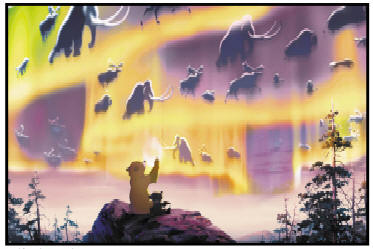Toon Talk: Brother Bear Special Edition DVD
Page 2 of 3

(c) Disney
Bonus Feature Highlights:
As previously stated, Disc 1’s bonus features are heavy on the ‘cub-friendly’ variety, and can basically be divided into four types:
-
Music: the Phil Collins “Look Through My Eyes�? Music Video and the “On My Way�? Sing Along Song.
-
Educational: The Bear Legends featurette (Tanana narrates as a series of cave paintings tell such folk tales as where bears came from), Making Noise (the voice of Koda, Jeremy Suerez, hosts a brief look at how sound effects are created through the use of Foley artists, in what appears to be a Disney Channel promo) and an Art Review (basically a mini-‘making of’ for kids, art director Robh Ruppel and Kenai-as-bear supervising animator Byron Howard reveal how Inuit designs helped inspire the looks of the characters, as seen through concept art and inspirational paintings).
-
Games: Sitka leads you through a seemingly unending supply of Bone Games, where you piece together animal bones and are rewarded with informational snippets of the beasts in question, using stock footage from the Disney archives, including clips from the True Life Adventures and several animated characters, such as Baloo, Thumper, Meeko, Chip ‘n Dale and, of course, the cast of Brother Bear. Also, Tanana helps you Find Your Totem in yet another variation of the personality game last seen on the Sleeping Beauty DVD (I am a “falcon of adventure�?, for what its worth …).
-
Humor: In Koda’s Outtakes, the little cub screens a series of Pixar-like bloopers from the ‘filming’ of the movie; some are funny (such as a surprise cameo by a certain mischievous troublemaker), but overall they just don’t feel appropriate for the otherwise serious tone of the feature (the same can be said of the ‘deformed bear’ bit at the top of the credits). And in lieu of a director’s commentary, Disney has turned the reigns over to those scene-stealers, Rutt and Tuke, for an ‘exclusive’ Moose Commentary. What sounds like a hoot and a half turns out to be only mildly amusing; the improv skills of R & T’s ‘other halves’, Rick Moranis and Dave Thomas, have thinned over the years since their SCTV days, but a couple chuckles do emerge, such as the duos constant referrals to Denahi as “that Antonio Banderas guy�? and their insistence that chipmunks are “harbingers of danger�?. The commentary can be played with or without ‘moose visuals’, which don’t real add much. Hilariously, the usual commentary disclaimer (“the opinions of those in the commentary do not reflect the opinions of the studio blah-blah-blah… �?) runs prior.
Disc 2, devoted to a more serious look at the film, consists mostly of the feature Paths of Discovery: The Making of ‘Brother Bear’, which itself is divided into four sections, which can be viewed separately or played together:
- In Beginnings, it is revealed that the genesis of Bear goes all the way back to The Lion King (OK, its not that big a revelation); supposedly it was Michael Eisner’s idea to create a story about “bears in North America�?. (Although Eisner himself never appears, he is mentioned a suspiciously large number of times throughout the doc, as opposed to those of previous films.) Directors Bob Walker and Aaron Blaise and producer Chuck Williams discuss the film’s themes of “forgiveness and brotherhood�?. Also of note is the character of Grizz, a Humphrey-like bear who was originally Kenai’s guide through the bear world before it was decided to go the cute-and-cuddly route with Koda. (Grizz was to be voiced by The Green Mile’s Michael Clark Duncan, who stuck around after his co-starring role was cut to voice the smaller role of Tug, the leader of the bears at the salmon run.)
- Welcome to the Family profiles the cast and animators who brought the characters to life, including voice actors Joaquin Phoenix (Kenai), D.B Sweeney (Sitka), Thomas, Moranis, Raize and Suarez and supervising animators Jim Jackson (human Kenai), Broose Johnson and Tony Stanley (Rutt and Tuke), Ruben Aquino (Denahi), Alex Kupershmidt (Koda) and Howard.
- Mirror to the World brings Ruppel back to discuss the film’s “painterly naturalism�?, a look that harkens back to Bambi, as well as how the production’s research trips to Alaska and Yellowstone National Park informed the overall look of the film.
- As would be expected, songwriter Phil Collins is the star of the Music and Songs section, which details how Collins came to co-compose the score of the film with Tarzan's Mark Mancina and why the decision was made to bring in other vocalists, such as Tina Turner and the Blind Boys of Alabama, for some of the songs heard in the film.
Rounding out Disc 2 are a trio of Deleted Scenes (including the deleted character of Muri the squirrel, a hybrid of Timon, Scrat and Pepe LePue), the deleted musical number “The Fishing Song�? (a more percussive, party-time take on the salmon run scene, which was changed to “Welcome�? when a more soulful, familial take on the bears was required) and a look at the recording of the Bulgarian Women’s Choir singing the “Transformation�? song in Inuit, with Collins’ English lyrics provided for a sort-of multi-lingual sing along.
